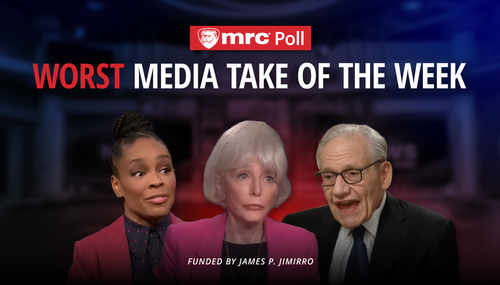Howard Kurtz should apologize to conservative author S. E. Cupp for how he and his fellow panelists treated her on Sunday's "Reliable Sources."
As Cupp via a satellite feed tried to explain the point Delaware Republican senatorial candidate Christine O'Donnell was making about the First Amendment during last week's debate with Chris Coons, those in the studio could be heard in the background laughing (video follows with transcript and commentary):
HOWARD KURTZ, HOST: Let me come back to S.E. Cupp, because you made a reference to Christine O'Donnell and the Constitution, so, in an effort to inject a little substance here, let me play the answer that she gave that got a lot of attention during the debate in that Delaware Senate race.
(BEGIN VIDEO CLIP)
CHRISTINE O'DONNELL (R), DELAWARE SENATE CANDIDATE: Where in the Constitution is the separation of church and state?
(LAUGHTER)
CHRIS COONS (D), DELAWARE SENATE CANDIDATE: Back to Roe versus Wade --
O'DONNELLL: (INAUDIBLE) separation of church and state is in the First Amendment?
(END VIDEO CLIP)
KURTZ: So, isn't it fair for the press to point out that a candidate who talks about the Constitution seems pretty unfamiliar with the First Amendment?

KURTZ: Come on.
CUPP: No. That's factual. It's not in there.
And what she was saying was a counter-response to this new liberal idea that the Constitution protects freedom from religion, when really it protects freedom of religion. And the idea that worship should be private and sort of kept to yourself, that's what she was reacting to.
But the liberal media jumped on that and said, oh, she has no idea what she's talking about, she doesn't know about the Constitution, she's a right-wing extremist. This is why.
And by the way, it's not just reporters. It's these debates. The way that the moderators, whether it's George Stephanopoulos or Wolf Blitzer, are handling these questions are making even, you know, the most sort of unfamiliar and politically unengaged viewer very aware that there is a bias in the media. I mean, it's blatant.
KURTZ: OK.
Let me get a brief response from Clarence Page.
CLARENCE PAGE, CHICAGO TRIBUNE: I invite everybody, first of all, to read the Fist Amendment and decide for yourself. Obviously, this is a pedantic argument about semantics, but what's more important is, blaming the media is usually a tactic of losing campaigns. So I'm rather perplexed that the Tea Party folks, who obviously have an advantage, according to the polls right now, are taking this tact. Let's see if it works or not.
TERRENCE SMITH, FMR. MEDIA CORRESPONDENT, NPR: We'll find out on Election Day.
KURTZ: Which is not too far away. S.E. Cupp, thanks very much, in Dallas.
Okay, well why don't take Page's advice and read the First Amendment:
Congress shall make no law respecting an establishment of religion, or prohibiting the free exercise thereof; or abridging the freedom of speech, or of the press; or the right of the people peaceably to assemble, and to petition the Government for a redress of grievances.
See anything in there about the separation of church and state?
As Investor's Business Daily pointed out Tuesday, the Supreme Court in historically recent years took it upon itself to divine the existence of such a separation:
Talk-radio king and Landmark Legal Foundation President Mark R. Levin explained the confusion of liberal judges and trial lawyers in his 2005 book, "Men in Black: How the Supreme Court is Destroying America."
The "Wall of Separation" phrase comes not from the Constitution, but from President Jefferson's letter to the Danbury Baptists in 1802. As Levin notes, the obscure comment was virtually ignored for nearly a century and a half. It wasn't until 1947 when Supreme Court Justice Hugo Black ruled in the Everson case — which actually upheld the use of taxpayer money to transport children to Catholic and other parochial schools — that the Jefferson metaphor was used to establish "the anti-religious precedent that has done so much damage to religious freedom."
Levin's argument is similar to that of the late Chief Justice William Rehnquist. In his dissent in a 1985 ruling against silent school prayer, Rehnquist pointed out: "There is simply no historical foundation for the proposition that the Framers intended to build the 'wall of separation' that was constitutionalized in Everson." He called Jefferson's "wall" "a metaphor based on bad history, a metaphor which has proved useless as a guide to judging."
In his book "The Theme is Freedom," veteran journalist M. Stanton Evans points out that this false view of the Founders as "separationists" led to "a revolution in our legal theory, educational system, and religious practice — including such departures as barring Christmas manger scenes from tax-supported settings."
Columbia Law School Professor Phillip Hamburger in his 2002 book "Separation of Church and State" argues that the early Americans enacted the Establishment Clause to prevent the corruption of religion by worldly influences, and that "the constitutional authority for separation is without historical foundation."
Of course, Kurtz, Page and Smith likely don't agree with the scholars IBD quoted, but laughing at a guest who does not only shows their own biases but also seems extremely unprofessional.




